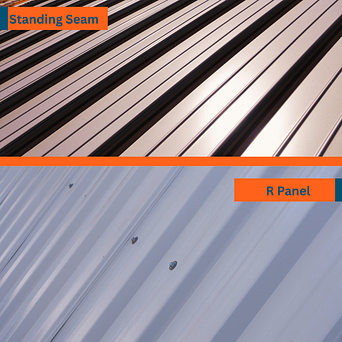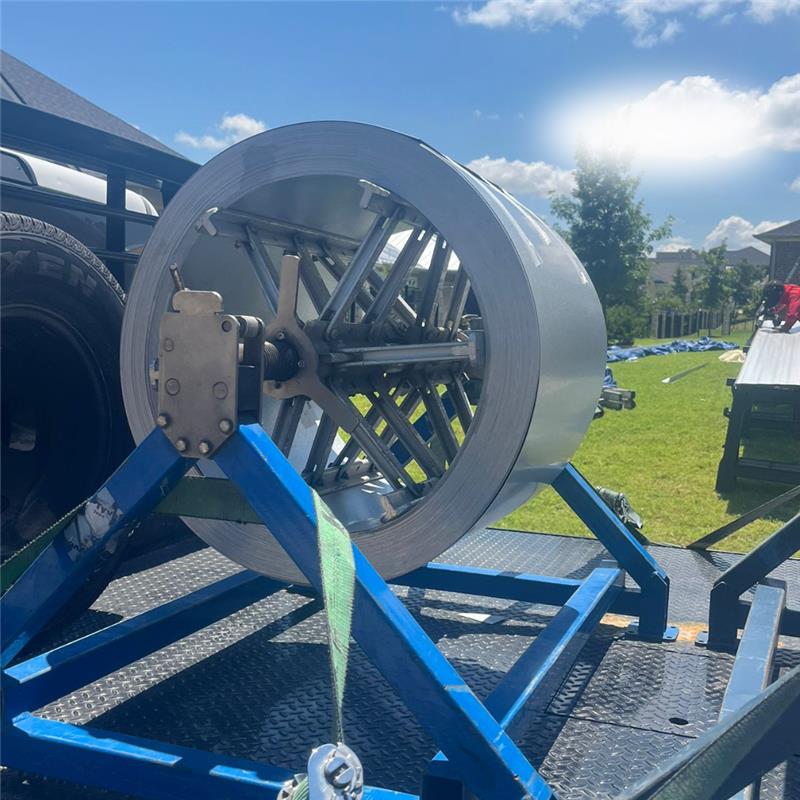When planning a new metal roof, one of the most important decisions you’ll make is the type of panel system to install. Among the most popular choices in Texas and beyond are standing seam panels and exposed fastener panels (R-Panels) Each comes with its own set of benefits and trade-offs, making the choice between them crucial for your home or commercial building’s performance and appearance.
In this comprehensive metal roof panel comparison, we’ll break down standing seam vs. exposed fastener panels (R-Panels) in terms of cost, installation methods, durability, aesthetic considerations, and panel maintenance. Whether you’re a homeowner, contractor, or architect, understanding these differences can help you choose the right system for your needs.
Understanding the Basics: Standing Seam vs. Exposed Fastener Panels (R-Panels)
Before we dive into the specifics, let’s define the two types of metal roofing panels:
- Standing Seam Panels feature interlocking seams that rise above the panel’s flat surface. Fasteners are concealed beneath these seams, resulting in a sleek, uninterrupted look.
- Exposed Fastener Panels (R-Panels), on the other hand, are attached with screws that penetrate the face of the panel, making the fasteners visible on the roof surface.
At first glance, these two systems may look similar, but they perform quite differently under real-world conditions—especially in a climate as varied as Texas.
1. Installation Methods: Simplicity vs. Precision
Installation methods are a major point of differentiation between these two metal roofing systems.
Exposed Fastener Panels
Exposed fastener systems, such as R-panels or corrugated sheets, are relatively easy and fast to install. Because the fasteners are driven directly through the panel into the structure below, the process requires less specialized labor and can typically be completed in less time.
Great for quick installation on barns, warehouses, and utility buildings.
However, improper screw alignment or over-tightening can compromise waterproofing and aesthetics.
Standing Seam Panels
Standing seam systems require a more complex installation process. Specialized clips and hidden fasteners are used to attach the panels, and installers often need tools like a seamer for field-locking panel seams.
Requires experienced professionals for correct placement and sealing.
For this reason, standing seam panels are often chosen for high-end residential or commercial applications where long-term performance is a priority.
Explore available panel systems for every application:
Metal Panels at Fasteel Metal Roofing Supply
2. Cost Differences: Upfront vs. Long-Term Value
When comparing cost differences between standing seam and exposed fastener panels, the upfront price tag often becomes a major factor in decision-making.
Exposed Fastener Panels (R-Panels) – Budget-Friendly Option
Exposed fastener panels are generally more affordable, both in terms of material cost and labor. For budget-conscious projects, this system makes a lot of sense.
Lower cost per square foot makes them popular for agricultural and industrial buildings in Texas.
Standing Seam Panels – Long-Term Investment
Standing seam systems can cost 30–50% more due to higher material quality, labor intensity, and the use of more components. However, this higher initial investment is often offset by reduced maintenance, better weather resistance, and longer lifespan.
Looking to source top-tier coils and flat sheets for standing seam fabrication?
View Coils & Flat Sheets
3. Durability Comparison: Performance Over Time
In the Texas roofing market, durability is a non-negotiable factor. The extreme heat, hailstorms, and seasonal temperature swings can wreak havoc on inferior roofing systems.
Exposed Fastener Panels (R-Panels)
These systems can last 20–30 years when properly installed and maintained. However, because fasteners are exposed, they are vulnerable to UV breakdown, expansion/contraction movement, and water intrusion over time.
Fastener gaskets can deteriorate, leading to leaks if not monitored regularly.
Standing Seam Panels
Standing seam systems are generally more durable and weather resistant. With no exposed fasteners, there’s far less risk of failure from water penetration or sealant degradation. These roofs can easily last 40–60 years or more with minimal upkeep.
Best-in-class for high-wind and hail-prone regions.
4. Aesthetic Considerations: Clean Lines vs. Rustic Charm
Design and curb appeal play a key role in metal roofing, especially for residential projects.
Exposed Fastener Panels (R-Panels)
These panels offer a bold, utilitarian appearance, which can work well for barns, cabins, or industrial-style buildings. The visible screw heads can either add to the character or feel out of place in upscale environments.
Great for rustic settings or when authenticity is valued.
Standing Seam Panels
With clean vertical lines and a smooth finish, standing seam panels provide a modern, upscale appearance. They are often seen on contemporary homes, civic buildings, and retail storefronts.
Highly sought after for high-end residential and commercial projects in Texas.
5. Panel Maintenance: Ease vs. Frequency
One of the long-term considerations in this metal roof panel comparison is the level of panel maintenance required.
Maintenance for Exposed Fastener Systems (R-Panels)
Exposed fastener roofs require more frequent inspections—especially after extreme weather events. Fasteners can back out or degrade, and re-screwing or replacing deteriorated seals may be necessary every few years.
Regular screw-tightening and sealant checks are essential.
Maintenance for Standing Seam Roofs
Standing seam systems are often referred to as “low maintenance” roofing. With hidden fasteners and fewer penetration points, there is less risk of component failure.
Annual inspections are usually sufficient unless severe weather causes damage.
6. Use Cases in Texas: Where Each System Excels
Because of Texas’ diverse landscape and architectural needs, both systems find their place in different applications.
- Exposed fastener panels (R-Panels) are ideal for agricultural buildings, carports, storage units, and cost-sensitive projects.
- Standing seam panels are best suited for residential roofing, churches, retail spaces, and institutional buildings where performance and appearance are equally important.
For a trusted supplier of Texas roofing panels in both categories, explore:
Fasteel Metal Roofing Supply
7. Environmental and Energy Efficiency
In today’s construction landscape, sustainability is becoming a higher priority.
Reflectivity and Cool Roofing
Both standing seam and exposed fastener panels can be coated with cool roof finishes that reflect sunlight and reduce HVAC costs. However, standing seam systems often pair better with solar panel integration due to their concealed fastener design and increased structural integrity.
Standing seam is ideal for eco-conscious building designs.
Final Verdict: Standing Seam vs. Exposed Fastener Panels (R-Panels)
| Feature | Exposed Fastener Panels (R-Panels) | Standing Seam Panels |
| Installation Cost | Lower | Higher |
| Labor Complexity | Simple | Advanced |
| Durability | Moderate (20–30 years) | High (40–60+ years) |
| Maintenance | Regular tightening needed | Minimal maintenance |
| Aesthetics | Rustic/Industrial look | Sleek/Modern appearance |
| Best Use Cases | Barns, Sheds, Workshops | Homes, Offices, Churches |
| Weather Resistance | Vulnerable at fasteners | Excellent due to concealed seams |
| Solar Compatibility | Limited | Excellent |
Choosing between standing seam and exposed fastener panels (R-Panels) ultimately depends on your goals: budget, lifespan, appearance, and maintenance needs. For homeowners seeking longevity and minimal upkeep, standing seam panels are the gold standard. For commercial or agricultural projects on a tighter budget, exposed fastener panels (R-Panels) offer unbeatable value.
Choosing the Right Supplier for Texas Roofing Panels
No matter your choice, sourcing your materials from a reliable supplier is essential. At Fasteel Metal Roofing Supply, we offer a full range of metal panel options, custom color choices, coils and flat sheets, and expert customer support.
- Need custom lengths or specialty finishes?
Browse Our Metal Panels
- Looking for flat sheets and coils for fabrication?
Check Out Our Coils & Flat Sheets
Conclusion
The debate between standing seam vs. exposed fastener panels (R-Panels) is more than just a style choice—it’s a decision that impacts cost, performance, and long-term satisfaction. By understanding their differences in installation methods, durability comparison, aesthetic considerations, and panel maintenance, you’re in a better position to make an informed investment.
Whether you’re roofing a ranch in rural Texas or a modern home in San Antonio or another city in Texas, the right metal panel system can enhance your property’s value, appearance, and weather protection for decades to come.






